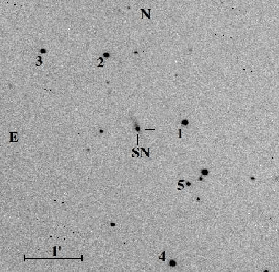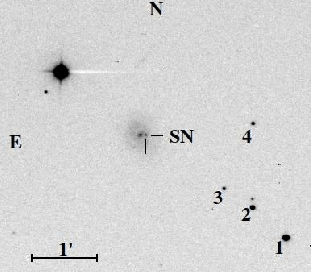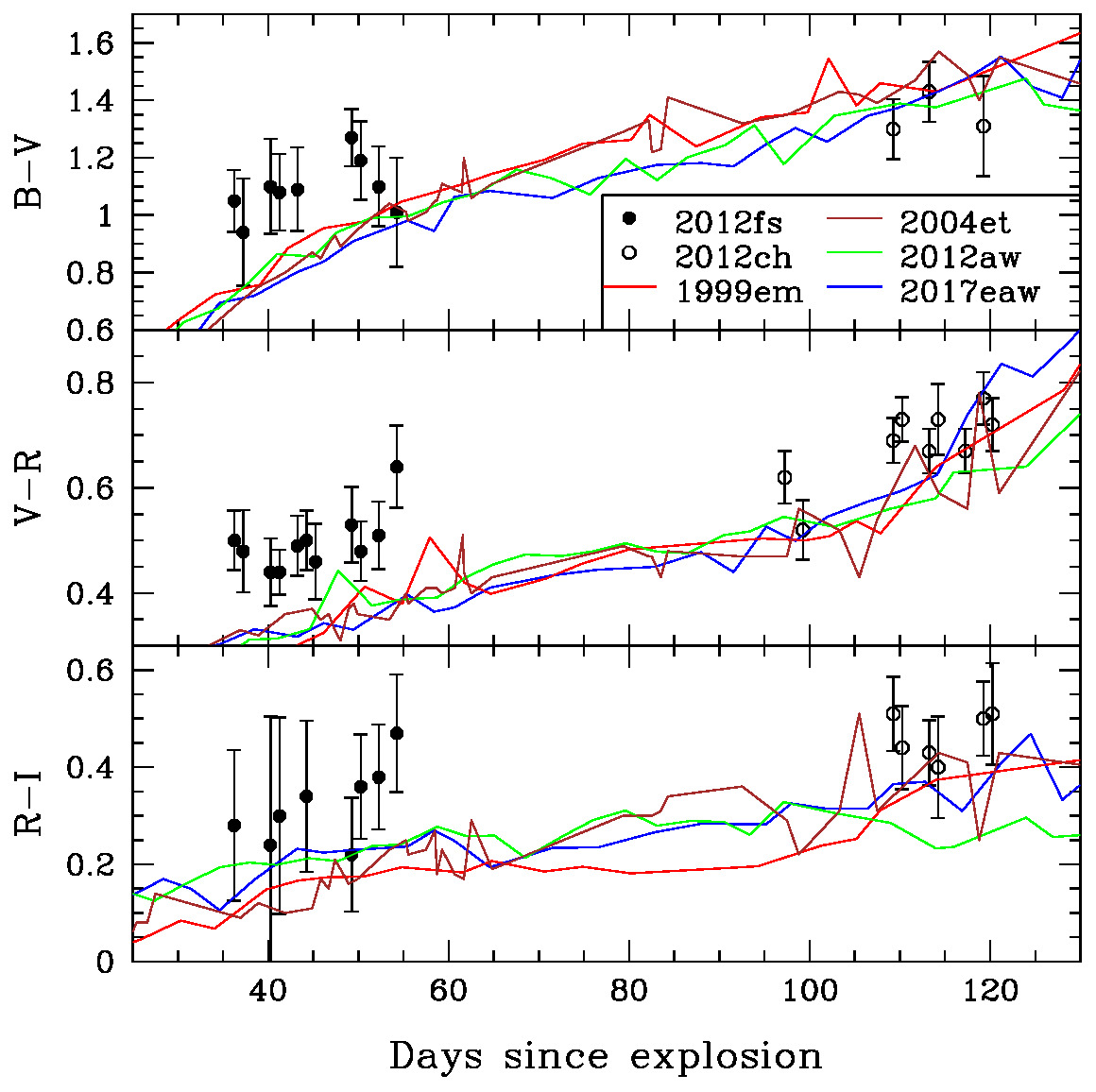|
Peremennye Zvezdy (Variable Stars) 44, No. 12, 2024 Received 6 December; accepted 12 December. |
Article in PDF |
|
DOI: 10.24412/2221-0474-2024-44-139-147
|
The Light Curves of Two Type II-P Supernovae: 2012ch and 2012fs
D. Yu. Tsvetkov1, N. N. Pavlyuk1, P. V. Baklanov1,2,3, V. M. Lipunov1
- M.V.Lomonosov Moscow State University, Sternberg
Astronomical Institute, Universitetskii pr.13, 119234 Moscow,
Russia
- National Research Center "Kurchatov Institute",
123182 Moscow, Russia
- Lebedev Physical Institute, Russian Academy of Sciences, 119333 Moscow, Russia
|
Photometric observations of SNe 2012ch and 2012fs show light
curves characteristic of type II-P Supernovae. The interstellar
extinction for both SNe was estimated by comparison of their color
curves with those for well-studied SNe II-P. The absolute
magnitudes at the plateau stage are
|
1. Introduction
Type II Supernovae are the result of explosions of massive stars
(
![]() ) that retained their hydrogen envelopes (e.g.
Smartt et al. 2009). Among these objects, the most frequent ones
are type II-P SNe, which have nearly constant brightness for a
time interval of
) that retained their hydrogen envelopes (e.g.
Smartt et al. 2009). Among these objects, the most frequent ones
are type II-P SNe, which have nearly constant brightness for a
time interval of ![]() days after maximum (Anderson et al.
2014, Smith et al. 2011). The length of the plateau phase and
luminosity at the plateau exhibit significant diversity, which is
related to the physical parameters of the exploding stars (e.g.
Litvinova and Nadezhin 1985). It is important to expand the sample
of well-studied type II SNe also because SNe II have been
established as useful independent distance indicators (Hamuy &
Pinto 2002).
days after maximum (Anderson et al.
2014, Smith et al. 2011). The length of the plateau phase and
luminosity at the plateau exhibit significant diversity, which is
related to the physical parameters of the exploding stars (e.g.
Litvinova and Nadezhin 1985). It is important to expand the sample
of well-studied type II SNe also because SNe II have been
established as useful independent distance indicators (Hamuy &
Pinto 2002).
We present photometry of two type II-P SNe: SN 2012ch and SN 2012fs, for which very few data have been reported, although they were quite bright at maximum.
SN2012ch was discovered in unfiltered Catalina Sky Survey (CSS)
images obtained on May 17.38 UT. The position of the transient was
![]() (J2000); the offset from the center of the host galaxy was
(J2000); the offset from the center of the host galaxy was
![]() West,
West,
![]() South, and its brightness, 16
South, and its brightness, 16![]() 4
(Drake et al. 2012). A spectrum of the object was obtained on May
18 with the F.L. Whipple Observatory's 1.5-m telescope, it showed
that the object was a type II-P supernova before maximum light. A
good fit was found to the spectra of SN II-P 1999em at 4 days
before maximum, and the velocity of H
4
(Drake et al. 2012). A spectrum of the object was obtained on May
18 with the F.L. Whipple Observatory's 1.5-m telescope, it showed
that the object was a type II-P supernova before maximum light. A
good fit was found to the spectra of SN II-P 1999em at 4 days
before maximum, and the velocity of H![]() absorption was
measured as 14200 km s
absorption was
measured as 14200 km s![]() (Marion 2012). The host galaxy is
WISEA J150602.64+412535.3 at
(Marion 2012). The host galaxy is
WISEA J150602.64+412535.3 at ![]() , according to the
NASA/IPAC Extragalactic Database (NED)1.
, according to the
NASA/IPAC Extragalactic Database (NED)1.
SN2012fs was discovered by the Italian Supernovae Search Project
(ISSP) at brightness about 16![]() 5 on two unfiltered CCD images,
taken with the 0.28-m telescope of the Col Druscié Observatory
on Oct. 7.960 UT. The new object was located at
5 on two unfiltered CCD images,
taken with the 0.28-m telescope of the Col Druscié Observatory
on Oct. 7.960 UT. The new object was located at
![]() (J2000), which
is 6
(J2000), which
is 6
![]() West and 1
West and 1
![]() North of the nucleus of the galaxy
IC35 (Dimai 2012).
North of the nucleus of the galaxy
IC35 (Dimai 2012).
An optical spectrum of SN2012fs, obtained on Oct. 9 with the New Technology Telescope, showed that SN2012fs was a type II-P supernova, the best fit was to the spectrum of SN2004et within a few days from explosion (Inserra et al. 2012).
Two spectra of SN2012fs were presented by Lin et al. (2024), they appear typical of SNe II-P; the explosion date was estimated as JD2456199 (Sept. 29).
2. Observations and reductions
Photometric CCD observations of SNe 2012ch and 2012fs
in the ![]() bands
were
performed with the 60-cm telescope of the Crimean Astronomical
Station of Sternberg Astronomical Institute (SAI CAS).
bands
were
performed with the 60-cm telescope of the Crimean Astronomical
Station of Sternberg Astronomical Institute (SAI CAS).
Images of SN2012fs were also obtained at the 70-cm telescope in Moscow, SN2012ch was observed on one epoch at the 50-cm telescope of SAI CAS.
The unfiltered observations with MASTER telescopes (Lipunov et al., 2010) were carried out at Tunka, Amur, and Kislovodsk sites.
The standard image reductions and photometry were made using IRAF2. Photometric measurements of the SNe were made relative to local standard stars using PSF fitting with the IRAF DAOPHOT package. The galaxy background was subtracted using images of the host galaxies obtained at the SAI CAS 60-cm telescope two years after discovery of the SNe.
The images of SNe 2012ch and 2012fs and local standard stars are
presented in Figs. 1, 2. The stars for SN2012ch were calibrated
using APASS3 and
PanSTARRS4databases, the ![]() magnitides were converted to the
Johnson-Cousins
magnitides were converted to the
Johnson-Cousins ![]() magnitudes using relations from Jester et
al. (2005) and Kostov & Bonev (2018).
magnitudes using relations from Jester et
al. (2005) and Kostov & Bonev (2018).
The comparison stars for SN2012fs were calibrated using observations of Landolt standards. The magnitudes of local standard stars are reported in Tables 1, 2. The errors are presented in parentheses in both tables.
| Star | ||||
| 1 | 15.40 (0.02) | 14.77 (0.01) | 14.40 (0.01) | 14.06 (0.01) |
| 2 | 15.94 (0.02) | 15.31 (0.02) | 14.97 (0.02) | 14.62 (0.02) |
| 3 | 17.55 (0.04) | 16.35 (0.03) | 15.63 (0.02) | 15.07 (0.02) |
| 4 | 16.53 (0.02) | 15.22 (0.02) | 14.40 (0.03) | 13.79 (0.02) |
| 5 | 17.99 (0.04) | 16.98 (0.03) | 16.38 (0.03) | 15.86 (0.03) |
| Star | ||||
| 1 | 14.51 (0.04) | 13.75 (0.01) | 13.31 (0.01) | 12.93 (0.01) |
| 2 | 16.11 (0.04) | 15.39 (0.02) | 14.95 (0.02) | 14.56 (0.01) |
| 3 | 17.76 (0.04) | 16.73 (0.02) | 16.13 (0.01) | 15.64 (0.04) |
| 4 | 17.61 (0.04) | 16.75 (0.01) | 16.31 (0.02) | 15.81 (0.05) |
| JD |
Tel. | ||||
| 071.17 | 15.80 (0.05) | M40 | |||
| 076.27 | 15.73 (0.06) | M40 | |||
| 101.13 | 15.85 (0.05) | M40 | |||
| 154.36 | 16.63 (0.04) | 16.01 (0.03) | C60 | ||
| 156.29 | 16.56 (0.04) | 16.04 (0.04) | C50 | ||
| 166.32 | 18.20 (0.10) | 16.90 (0.03) | 16.21 (0.03) | 15.70 (0.07) | C60 |
| 167.39 | 16.97 (0.03) | 16.24 (0.03) | 15.80 (0.08) | C60 | |
| 170.25 | 18.40 (0.10) | 16.97 (0.03) | 16.30 (0.03) | 15.87 (0.06) | C60 |
| 171.33 | 17.06 (0.06) | 16.33 (0.03) | 15.93 (0.10) | C60 | |
| 174.34 | 17.14 (0.03) | 16.47 (0.03) | C60 | ||
| 176.33 | 18.62 (0.17) | 17.31 (0.04) | 16.54 (0.03) | 16.04 (0.07) | C60 |
| 177.36 | 17.32 (0.04) | 16.60 (0.03) | 16.09 (0.10) | C60 |
| JD |
Tel. | ||||
| 206.09 | 17.48 (0.08) | M40 | |||
| 216.16 | 17.49 (0.06) | M40 | |||
| 217.26 | 17.55 (0.04) | M40 | |||
| 236.32 | 19.10 (0.10) | 18.05 (0.04) | 17.55 (0.04) | 17.27 (0.15) | C60 |
| 237.32 | 19.02 (0.18) | 18.08 (0.05) | 17.60 (0.06) | C60 | |
| 240.30 | 19.15 (0.16) | 18.05 (0.04) | 17.61 (0.05) | 17.37 (0.26) | C60 |
| 241.31 | 19.14 (0.13) | 18.06 (0.03) | 17.62 (0.03) | 17.32 (0.20) | C60 |
| 243.32 | 19.18 (0.14) | 18.09 (0.04) | 17.60 (0.04) | C60 | |
| 244.31 | 18.10 (0.04) | 17.60 (0.04) | 17.26 (0.15) | C60 | |
| 245.27 | 18.05 (0.06) | 17.59 (0.04) | C60 | ||
| 249.32 | 19.42 (0.08) | 18.15 (0.06) | 17.62 (0.04) | 17.40 (0.11) | C60 |
| 250.32 | 19.25 (0.13) | 18.06 (0.04) | 17.58 (0.04) | 17.22 (0.10) | C60 |
| 252.27 | 19.27 (0.13) | 18.17 (0.05) | 17.66 (0.04) | 17.28 (0.10) | C60 |
| 254.23 | 19.28 (0.18) | 18.27 (0.06) | 17.63 (0.05) | 17.16 (0.11) | C60 |
| 281.24 | 17.40 (0.20) | M70 |
The magnitude estimates of the SNe on unfiltered MASTER images
were made using the ![]() -band magnitudes of local standards.
-band magnitudes of local standards.
The photometry is presented in Tables 3, 4, the identification of telescopes is given by codes: M70 is the 70-cm reflector in Moscow; M40 are the 40-cm MASTER telescopes; C60 is the 60-cm telescope of the SAI CAS; C50 is the 50-cm telescope of the SAI CAS.
3. The light and color curves
The light curves for SNe 2012ch and 2012fs are presented in Figs.
3, 4, they appear typical of SNe II-P. For SN2012ch, the
discovery magnitudes and comparison to our early data allow us to
conclude that the end of brightness increase and start of the
plateau phase occurred at about JD2456067. The description of
the classification spectrum by Marion et al. (2012) and comparison
to the data for SN1999em (Elmhamidi et al. 2003, Leonard et al.
2002) permit us to estimate that the explosion occurred in the
time interval JD2456054-2456058, assuming that the rise of
luminosity was similar for SNe 2012ch and 1999em.
The rise time ![]() 10 days is within the range of this quantity
for SNe II-P according to Gall et al. (2015). The data from
continuous monitoring with the C60 telescope shows that, in this
time interval, SN2012ch exhibited a fast brightness decline
after the plateau. We estimate that the end of the plateau
occurred at about JD2456150, and the length of the plateau was
10 days is within the range of this quantity
for SNe II-P according to Gall et al. (2015). The data from
continuous monitoring with the C60 telescope shows that, in this
time interval, SN2012ch exhibited a fast brightness decline
after the plateau. We estimate that the end of the plateau
occurred at about JD2456150, and the length of the plateau was
![]() 93 days, which is a typical value for SNe II-P.
93 days, which is a typical value for SNe II-P.
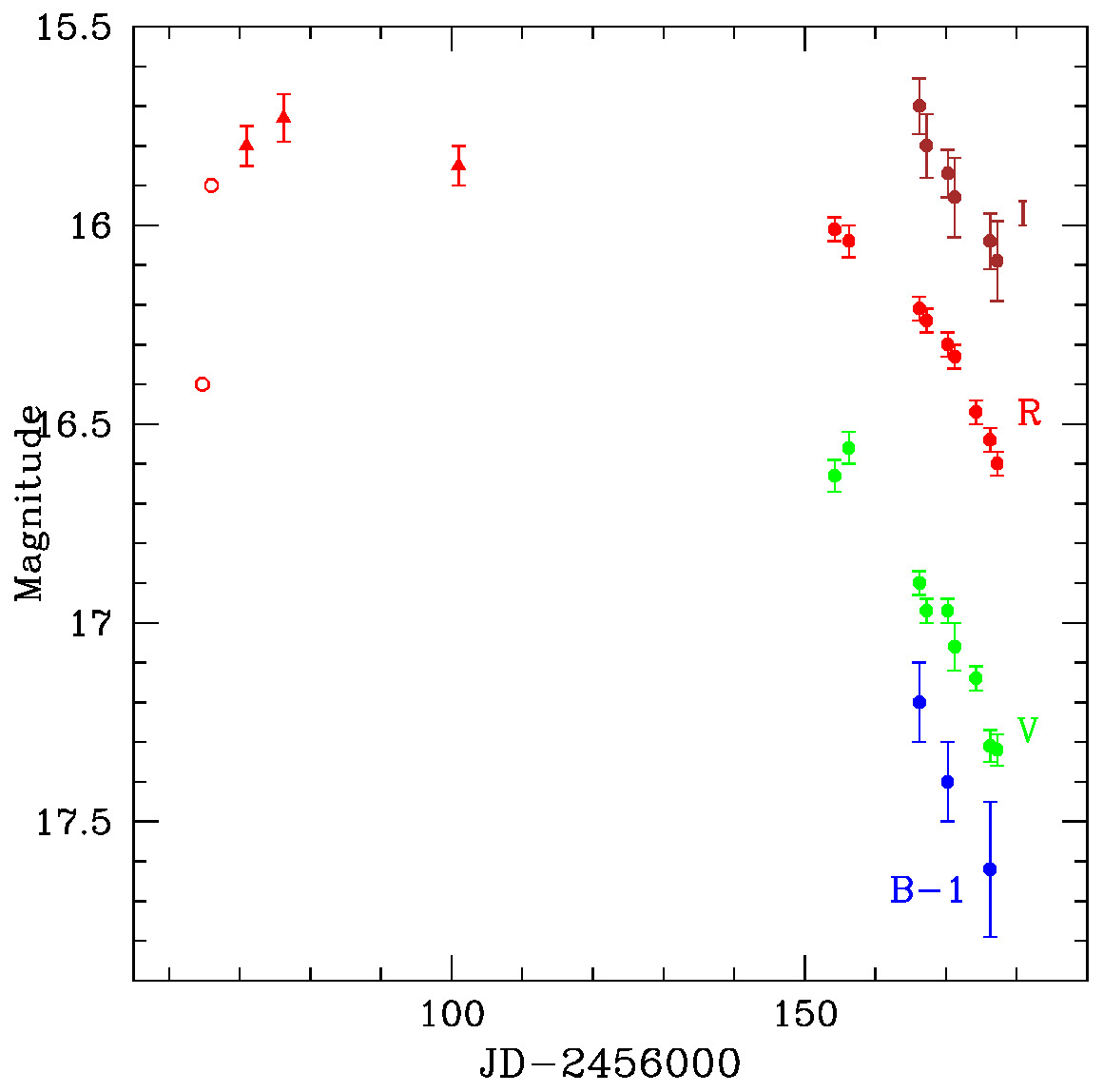 |
Fig. 3. The light curves of SN2012ch. Dots are observations with the C60 and C50 telescopes; triangles are data from the MASTER telescopes; circles are magnitude estimates at the discovery. |
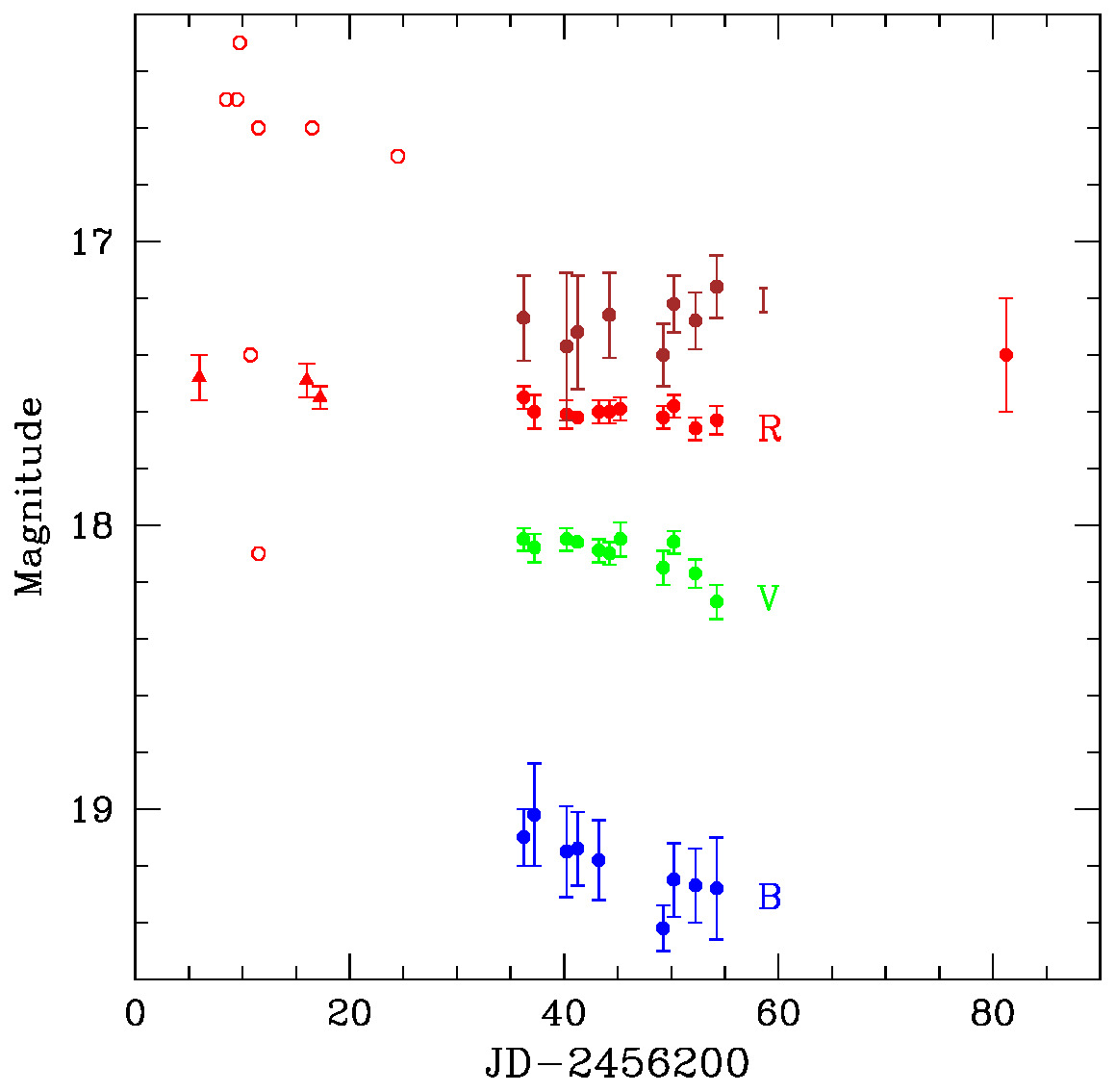 |
Fig. 4. The light curves of SN2012fs. Dots are observations with the C60 and M70 telescopes; triangles are data from the MASTER telescopes; circles are the discovery magnitude and estimates by amateurs, reported in CBET No. 3278. |
The data for SN2012fs indicate that all our observations were
obtained at the plateau phase. The discovery magnitude and other
estimates by amateurs show very large scatter, up to 2![]() . We
suppose that this is the result of difficulty of measuring the SN
near the nucleus of the galaxy, in the region of high background
surface brightness. The explosion epoch can be estimated only
using the data on SN spectra. The results of Inserra et al. (2012)
suggests the explosion date about JD2456200 (Sept. 30), while
Lin et al. (2024) determined that the explosion occurred on
JD2456199 (Sept. 29). Both estimates are in a good agreement,
and we accept JD2456199.5 as an explosion epoch. SN2012fs was
discovered on Oct. 7.96 (JD2456208.46), but out first images
were obtained 2 days earlier, on JD2456206.09, and at that time,
the SN has already reached the plateau. The rise time from these
data is about 6
. We
suppose that this is the result of difficulty of measuring the SN
near the nucleus of the galaxy, in the region of high background
surface brightness. The explosion epoch can be estimated only
using the data on SN spectra. The results of Inserra et al. (2012)
suggests the explosion date about JD2456200 (Sept. 30), while
Lin et al. (2024) determined that the explosion occurred on
JD2456199 (Sept. 29). Both estimates are in a good agreement,
and we accept JD2456199.5 as an explosion epoch. SN2012fs was
discovered on Oct. 7.96 (JD2456208.46), but out first images
were obtained 2 days earlier, on JD2456206.09, and at that time,
the SN has already reached the plateau. The rise time from these
data is about 6![]() 5, which is also within the range of this
quantity for SNe II-P according to Gall et al. (2015).
Unfortunately, we have no data after the phase
5, which is also within the range of this
quantity for SNe II-P according to Gall et al. (2015).
Unfortunately, we have no data after the phase ![]() 80 days and
cannot determine the length of the plateau.
80 days and
cannot determine the length of the plateau.
The color curves for SNe 2012ch and 2012fs are presented in Fig. 6, they are compared to those for type II-P SNe 1999em, 2004et, 2012aw, and 2017eaw (Elmhamidi et al. 2003; Maguire et al. 2010; Bose et al. 2013; Tsvetkov et al. 2018; Buta & Keel 2019).
The color curves for the SNe from the comparison sample were
corrected for extinction, the values were taken from the papers
cited above. All four color curves show similar behavior, with
constant reddening during the displayed time interval. The
comparison shows that the colors of SN2012fs clearly demonstrate
a significant color excess, while it is negligible for SN2012ch.
We estimate the color excess for SN2012fs as
![]() , while the Galactic extinction for the
host galaxy is
, while the Galactic extinction for the
host galaxy is
![]() from the NED. We conclude that
small extinction in the host galaxy,
from the NED. We conclude that
small extinction in the host galaxy,
![]() , is
also present. For SN2012ch, the Galactic extinction is
, is
also present. For SN2012ch, the Galactic extinction is
![]() (NED), and the extinction in the host galaxy is
negligible.
(NED), and the extinction in the host galaxy is
negligible.
The distances to the host galaxies of SNe 2012ch and 2012fs were
calculated from their redshifts, corrected for the motion relative
to the cosmic microwave background (NED), using ![]() km
s
km
s![]() Mpc
Mpc![]() . The resulting distance moduli are
. The resulting distance moduli are ![]() for SN2012ch and
for SN2012ch and ![]() for SN2012fs. Using the distances
and extinction derived above, we obtain the absolute magnitudes of
the SNe at the plateau stage:
for SN2012fs. Using the distances
and extinction derived above, we obtain the absolute magnitudes of
the SNe at the plateau stage:
![]() for SN2012ch,
for SN2012ch,
![]() for SN2012fs. The mean maximum absolute magnitude
in the
for SN2012fs. The mean maximum absolute magnitude
in the ![]() band for SNe II, according to Anderson et al. (2014),
is
band for SNe II, according to Anderson et al. (2014),
is
![]() . The color curves presented in
Fig. 6 show that the mean color index
. The color curves presented in
Fig. 6 show that the mean color index ![]() at the start of the
plateau stage for SNe II-P is about
at the start of the
plateau stage for SNe II-P is about
![]() , so the mean maximum
magnitude in the
, so the mean maximum
magnitude in the ![]() band is
band is
![]() . We
conclude that the maximum luminosity of the SNe 2012ch and 2012fs
is very close to the mean value for this class of objects.
. We
conclude that the maximum luminosity of the SNe 2012ch and 2012fs
is very close to the mean value for this class of objects.
Our study of the two type II-P SNe, 2012ch and 2012fs, shows that these objects present quite typical photometric behavior, although our data are quite sparse and do not cover all important stages of their evolution.
4. Modelling the light curves for SN2012ch
The data for SN2012ch allows us to determine such important parameters as the length of the plateau and luminosity on the plateau. We attempted modelling the light curves with the STELLA code that incorporates implicit hydrodynamics coupled to a time-dependent multi-group non-equilibrium radiative transfer (Blinnikov et al. 1998, 2000, 2006; Baklanov et al. 2005).
The explosion is initiated by energy release at the center of the
pre-supernova. A neutron star with mass 1.55![]() forms in
the center. We varied main parameters of the model: mass
forms in
the center. We varied main parameters of the model: mass
![]() and radius
and radius ![]() of the pre-supernova, explosion
energy
of the pre-supernova, explosion
energy
![]() , and mass of synthesized
, and mass of synthesized ![]() Ni
Ni ![]() ; we calculated a grid of models searching for better fit to
the observed light curves. The light curves and photospheric
velocity for the optimal model are presented in Fig. 6. The
parameters of this model are:
; we calculated a grid of models searching for better fit to
the observed light curves. The light curves and photospheric
velocity for the optimal model are presented in Fig. 6. The
parameters of this model are:
![]() ,
,
![]() ,
,
![]() ,
,
![]() erg. The single velocity
estimate for SN2012ch is based on blueshift of H
erg. The single velocity
estimate for SN2012ch is based on blueshift of H![]() absorption (Marion 2012). Dessart and Hillier (2005) showed that,
at that phase, the photospheric velocity was about 1.5 times lower
than the H
absorption (Marion 2012). Dessart and Hillier (2005) showed that,
at that phase, the photospheric velocity was about 1.5 times lower
than the H![]() velocity, so the agreement between our model
and observations is satisfactory. The derived model parameters are
quite typical of type II-P supernovae.
velocity, so the agreement between our model
and observations is satisfactory. The derived model parameters are
quite typical of type II-P supernovae.
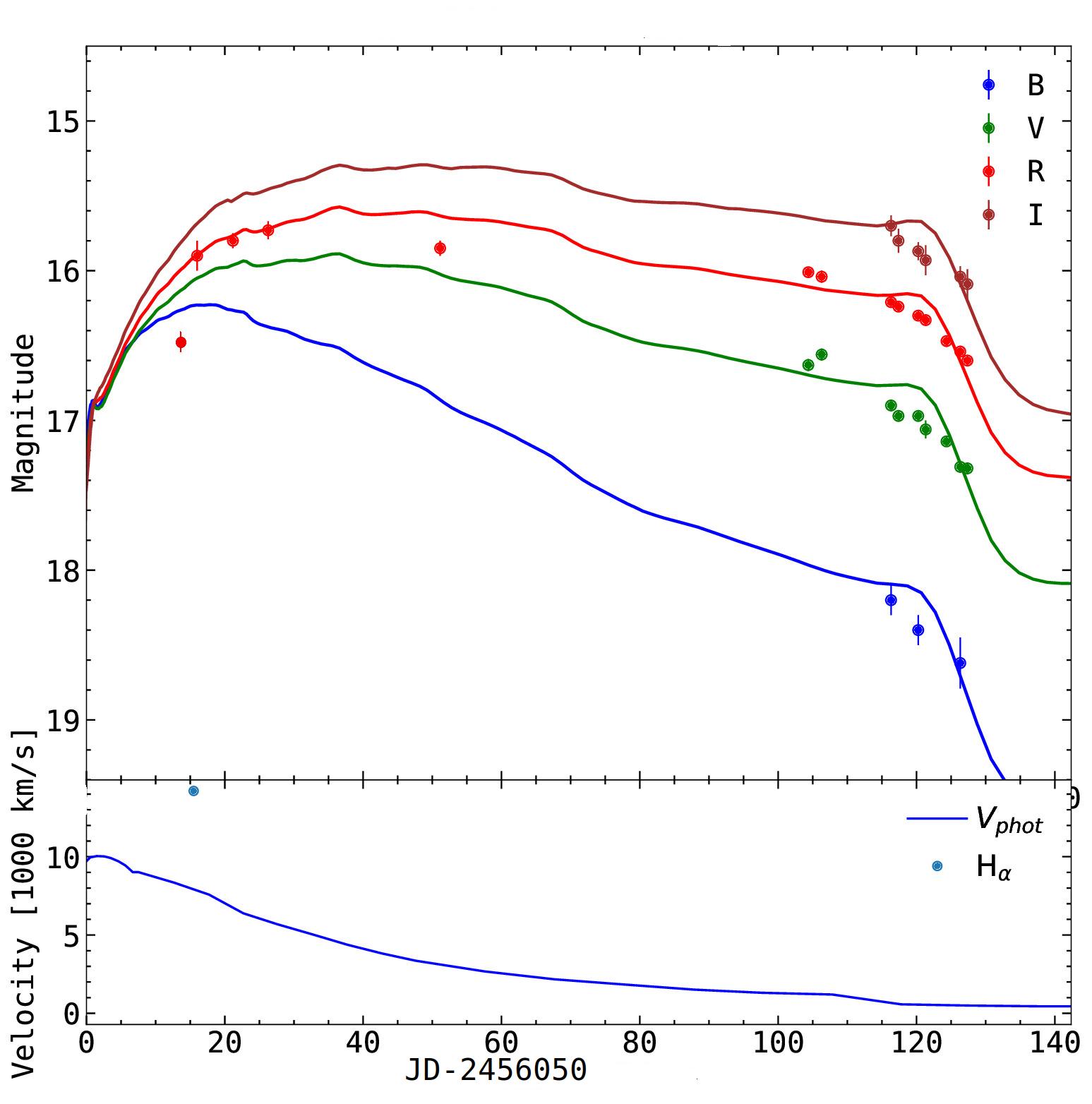 |
Fig. 6.
The |
Acknowledgments. The work of D. Tsvetkov on data reduction and analysis and work of P. Baklanov on modelling supernova light curves with the STELLA code were supported by RSF grant No. 24-12-00141.
References:
Anderson, J. P., Gonzalez-Gaitan, S., Hamuy, M., et al. 2014, Astrophys. J., 786, article id. 67
Baklanov, P. V., Blinnikov, S. I., & Pavlyuk, N. N. 2005, Astron. Letters 31, 429
Blinnikov, S. I., Eastman, R., Bartunov, O. S., et al. 1998, Astrophys. J., 496, 454
Blinnikov, S. I., Lundqvist, P., Bartunov, O. S., et al. 2000, Astrophys. J., 532, 1132
Blinnikov, S. I., Ropke, F. K., Sorokina, E. I., et al. 2006, Astron. & Astrophys. 453, 229
Bose, S., Kumar, B., Sutaria, F., et al. 2013 Monthly Notices Roy. Astron. Soc., 433, 1871
Buta, R. J. & Keel, W. C. 2019, Monthly Notices Roy. Astron. Soc., 487, 832
Dessart, D. & Hillier, D. J. 2005, Astron. & Astrophys., 439, 671
Dimai, A., 2012, CBET, No.3278
Drake, A. J., Djorgovski, S. J., Graham, M. J., et al. 2012, CBET, No.3118
Elmhamdi, A., Daniger, I. J., Chugai, N., et al. 2003, Monthly Notices Roy. Astron. Soc., 338, 939
Gall, E. E. E., Polshaw, J., Kotak, R., et al. 2015, Astron. & Astrophys., 582, article id. a3
Jester, S., Schneider, D. P., Richards, G. T., et al. 2005, Astron. J., 130, 873
Hamuy, M. & Pinto, P. A. 2002, Astrophys. J. Letters, 566, L63
Inserra, C., Smartt, S. J., Fraser, M., et al. 2012, CBET, No.3278
Kostov, A., Bonev, T., 2018, Bulgarian Astronomical Journal, 28, 3
Leonard, D. C., Filippenko, A. V., Gates, E. L., et al. 2002, Publ. Astron. Soc. Pacific, 114, 35
Lin, H., Wang, X., Zhang, J., et al. 2024, arXiv:2410.05889
Lipunov, V., Kornilov, V., Gorbovskoy, E., et al. 2010, Advances in Astronomy, article id. 349171
Litvinova, I. Yu. & Nadyozhin, D. K., 1985, Soviet Astronomy Letters, 11, 25
Maguire, K., Di Carlo, E., Smartt, S. J., et al. 2010, Monthly Notices Roy. Astron. Soc., 404, 981
Marion, G. H. 2012, CBET, No.3118
Smartt, S. J., Eldridge, J. J., Crockett, R. M., & Maund, J. R., 2009, Monthly Notices Roy. Astron. Soc., 395, 1409
Smith, N., Li, W., Filippenko, A. V., & Chornock, R., 2011, Monthly Notices Roy. Astron. Soc., 412, 1522
Tsvetkov, D. Yu., Shugarov, S. Yu., Volkov, I. M., et al. 2018, Astron. Letters, 44, 315
